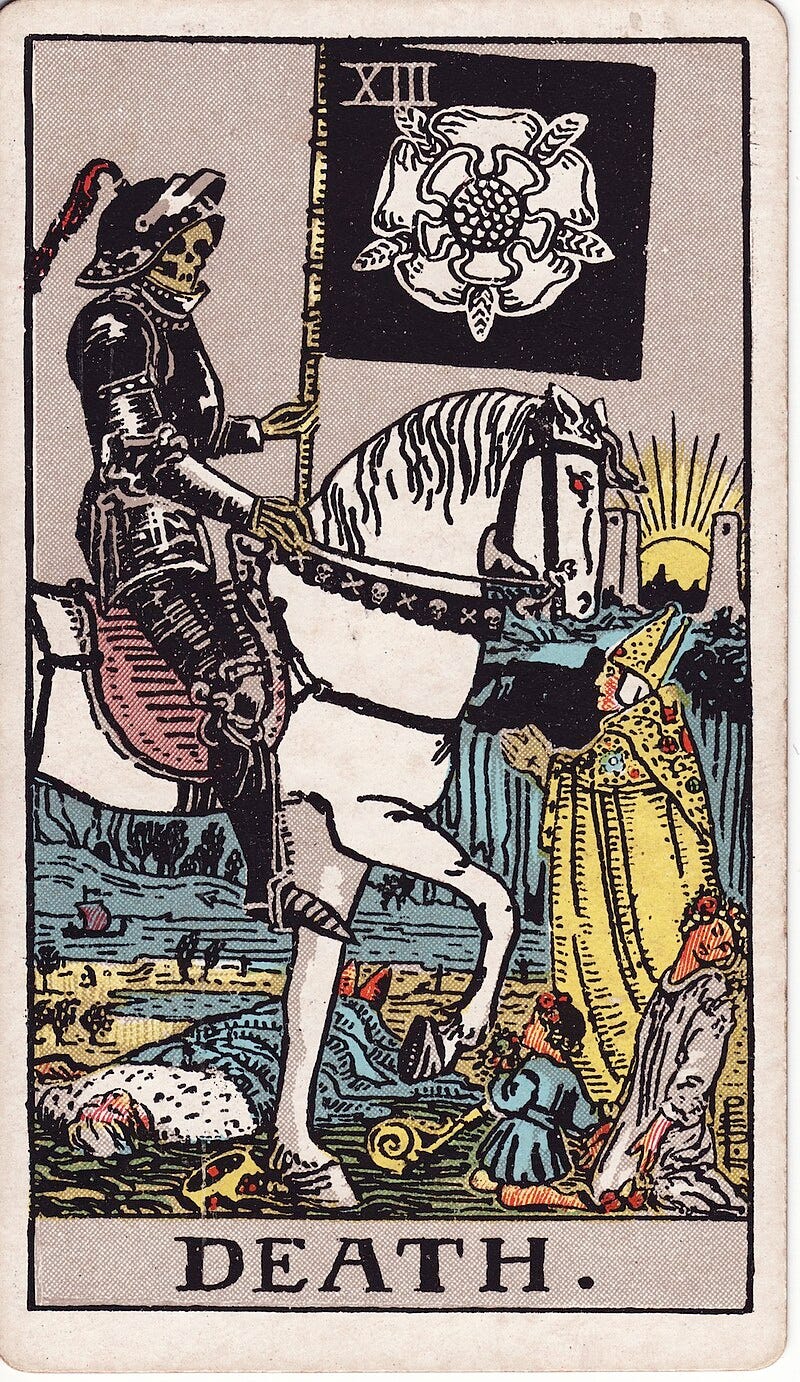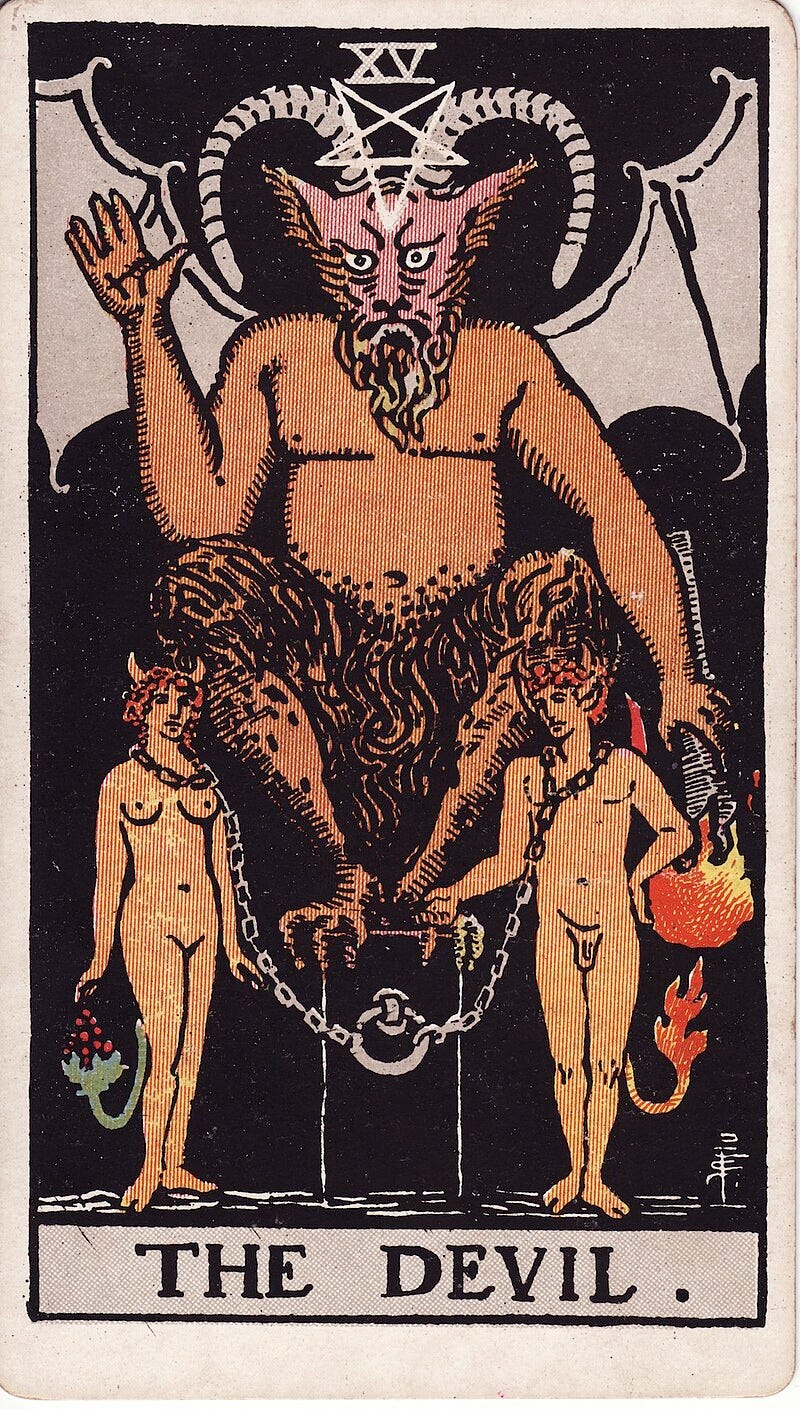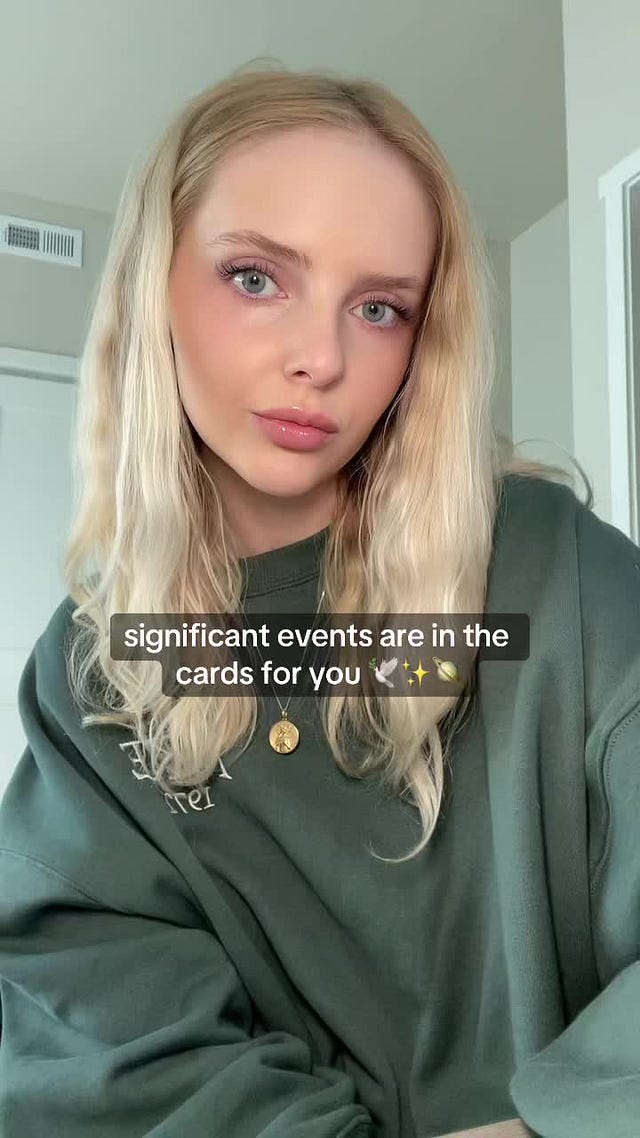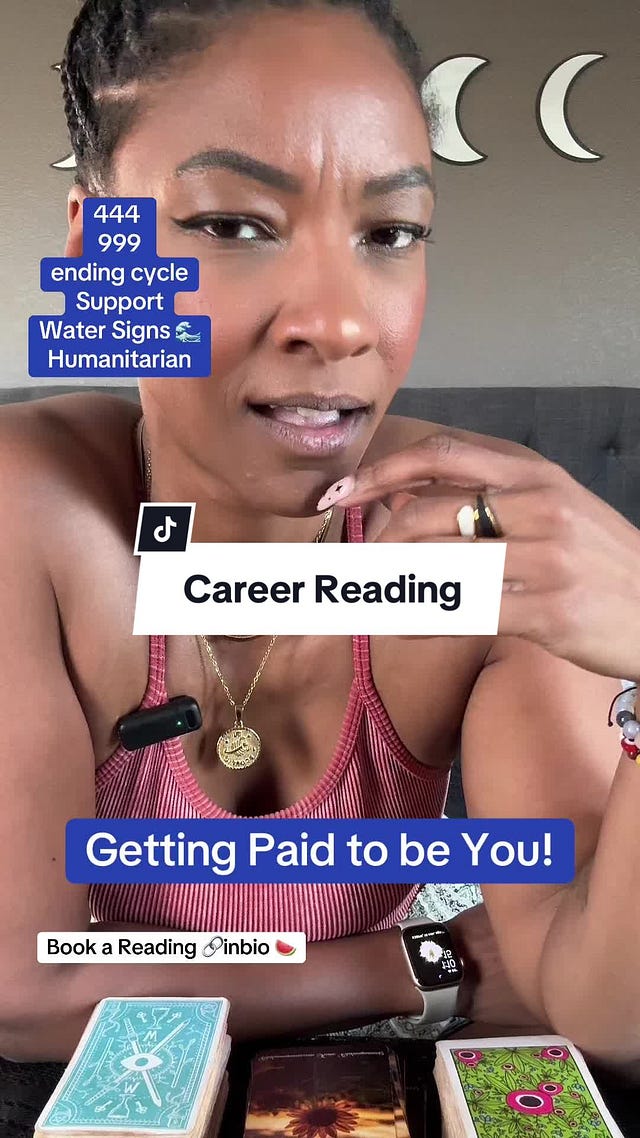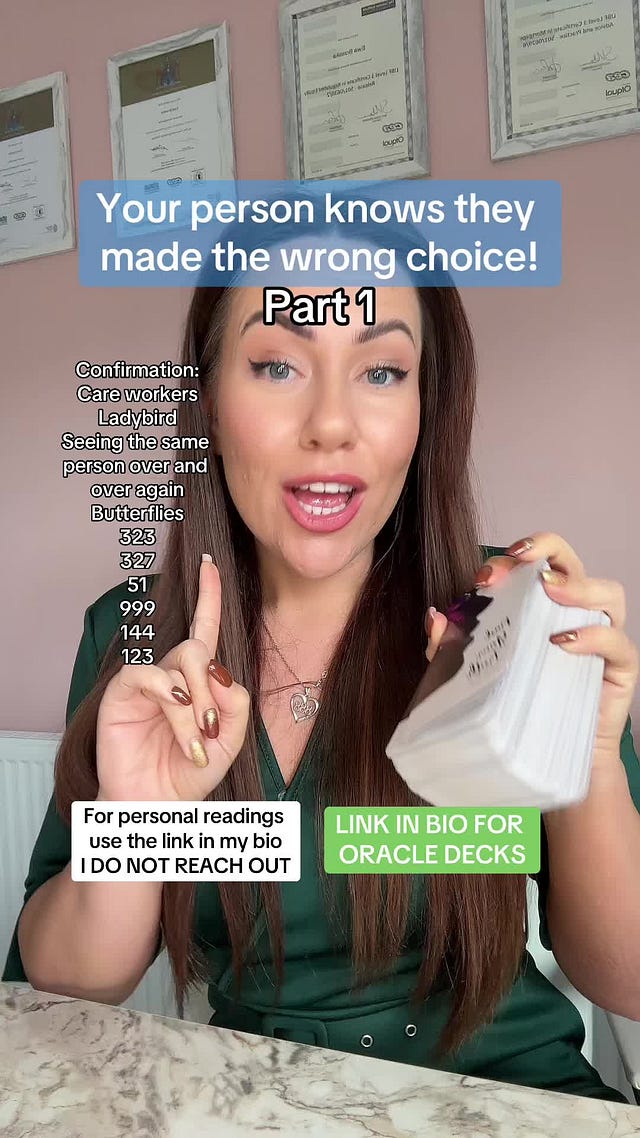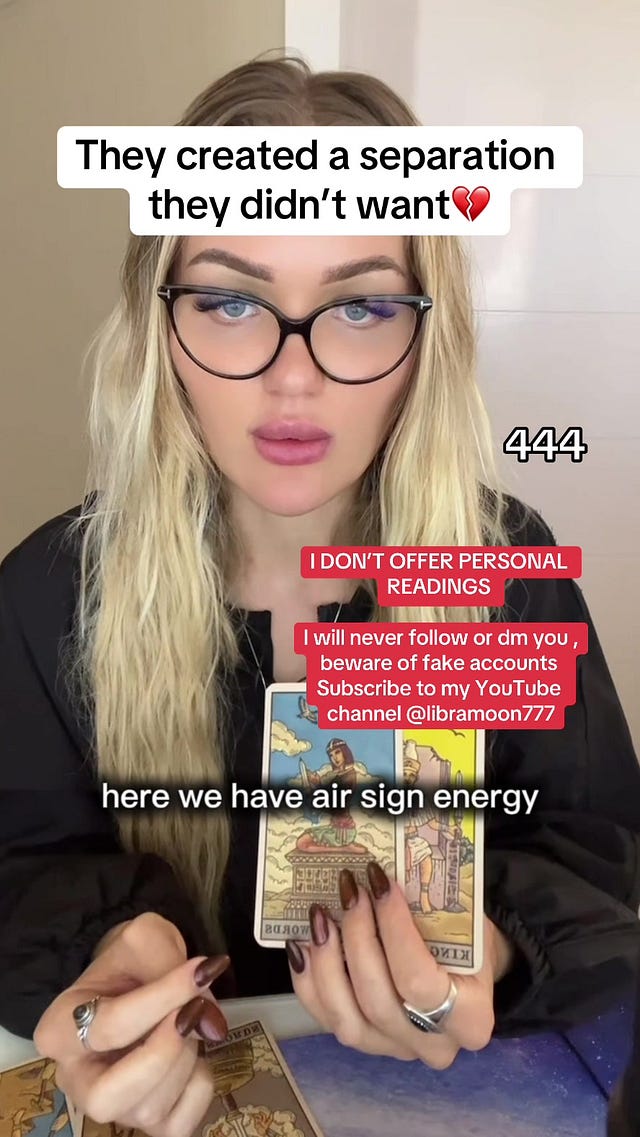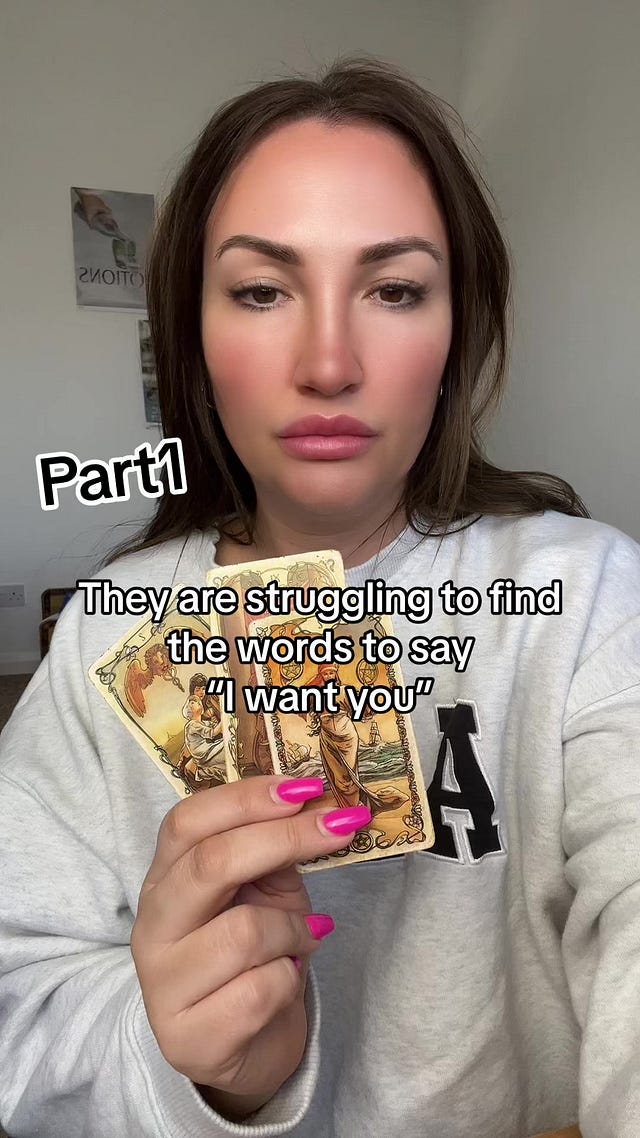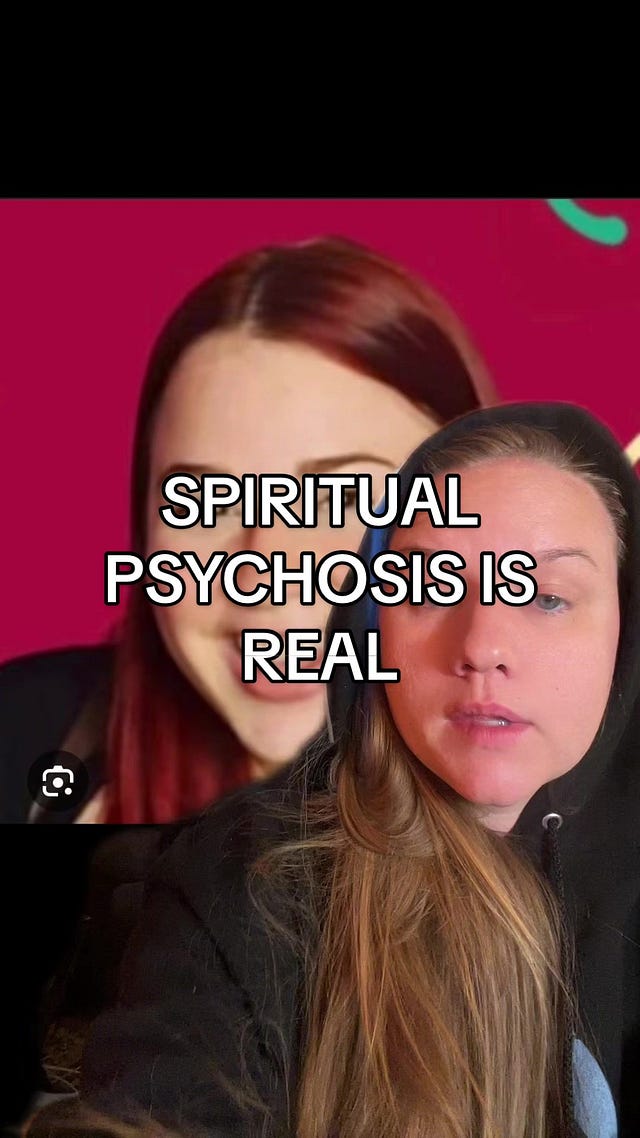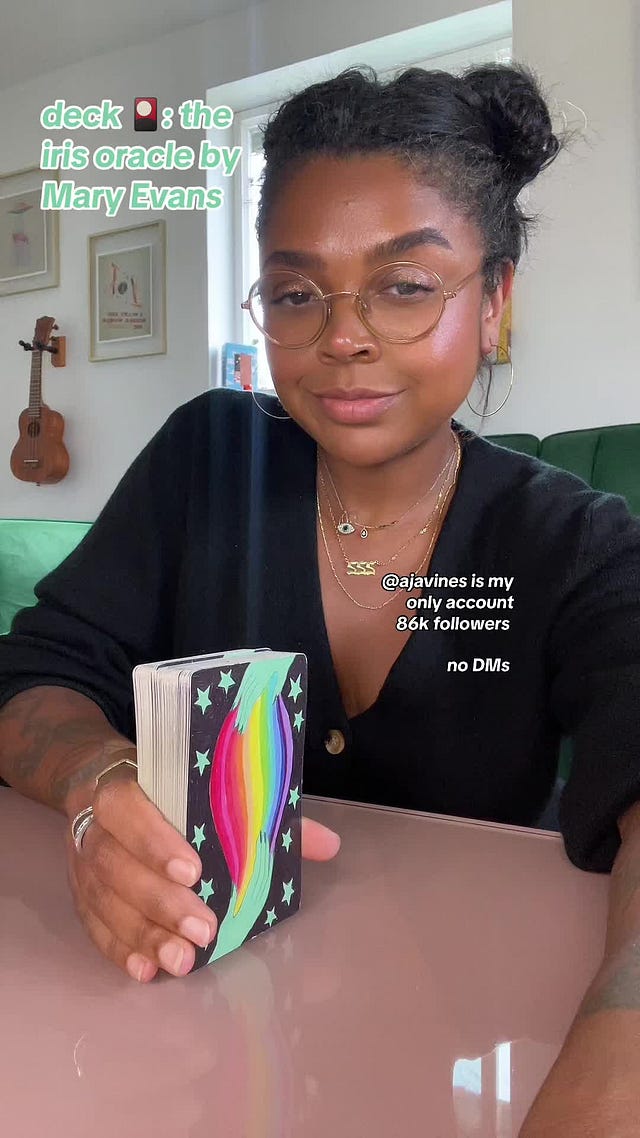Stop Scrolling: The Undeniable Allure of TikTok Tarot
"If this message found you, it found you for a reason."
I don’t mean to fear monger, or give the federal agents monitoring the situation any more reason to ban my favorite app. It’s just that: sometimes it feels like TikTok knows me better than I know me.
I could make an effort to become more in tune with what’s happening inside my body, but that would require effort—journaling, meditation, breath work. Who has the time?!
Some days, it’s easier to let the algorithm tell me how I’m feeling. If my FYP is primarily cute dogs, skincare advice, and Donghua Jinlong industrial-grade glycine, it’s safe to assume I’m in the clear. But sometimes, things start getting a little more… metaphysical. When this happens, it’s probably time to take a step back.
I don’t remember when, exactly, the tarot readers first started showing up on my For You Page. But one day last summer, there they were. “This message found you for a reason,” many of the videos begin. “There are no hashtags, no trending sounds. I put this out there with the intention that it would find who it needed to.”
Found me? For a reason? I was all ears. I was also depressed, which probably is why I stuck around to hear whatever message “fate” had decided to deposit in my TikTok queue. I must have watched the video all the way through—and maybe even bookmarked or liked it—which told the algorithm I’d be likely to engage with more tarot content. And boy was I!

Sorry/not sorry for stereotyping, because if you’re reading this newsletter, I suspect you already have at least a high-level understanding of what tarot is. But just in case you aren’t familiar, allow me to summarize. The tarot is a set of illustrated cards frequently used for divination, although it’s important to note that they weren’t invented as a fortune-telling tool. The system we know today as tarot is derived from playing cards first used in Italy in the 1400s, which included a set of trionfi or “trump” cards with illustrations depicting both virtues and archetypal figures that would have been instantly recognizable to anyone of the era (e.g., the King, the Pope, Charity, Faith). These cards were used to play a game called tarocchi, which to me sounds like an obscure pasta shape you’d order at a trendy Italian restaurant. (It would probably be served with ramps and foraged mushrooms or something.)
It wasn’t until the 18th century that these playing cards started becoming popular with occultists, who claimed the tradition of using the cards for divination went all the way back to ancient Egypt. But the earliest version of tarot specifically designed for fortune-telling was developed by the French occultist Etteilla in 1789. Whether or not he believed it, he leaned into this Egypt narrative, incorporating themes and images related to the Book of Thoth into his deck. (Side note: the Wikipedia page on tarot contains this savage quote: “Historians have described western views of the Tarot pack as ‘the subject of the most successful propaganda campaign ever launched... An entire false history and false interpretation of the Tarot pack was concocted by the occultists and it is all but universally believed.’”)
The most popular version of the tarot in use today, the Rider-Waite, is the work of occultist A.E. Waite and illustrator Pamela Colman Smith and was first published in 1909. Smith’s evocative, highly-detailed illustrations are instantly recognizable, even if you aren’t super familiar with the individual cards that comprise a deck. (In fact, many modern tarot practitioners refer to the Rider-Waite deck as the Rider-Waite-Smith or the Waite-Smith deck to give proper credit to the woman who was, arguably, the true visionary.)
Every one of Smith’s pictures is rich in symbolism and also—just in case you were about to write tarot off as fluffy girly stuff—pretty badass?! Please see cards number 13 (Death) and 15 (the Devil). I mean, it doesn’t get more metal than this.
A typical tarot deck consists of 78 cards, divided into the Major Arcana and the Minor Arcana. The Major Arcana, taken together, is said to depict “the Fool’s Journey”, with each card serving as a visual representation of a different season of life. There are numerous layers to each card, and interpretations can vary wildly depending on the specific contexts in which they show up.
Let’s take The Devil, for example. It can represent addiction, an unhealthy obsession, negative thought patterns—anything that could cause you to feel trapped. But take a look at the chains around the necks of the man and woman. They’re actually pretty loose, which suggests that they could free themselves at any time if they really wanted to. Their belief that they’re prisoners to a force greater than themselves is an illusion.
Just like the Devil’s prisoners, we all have narratives we cling to because they provide comfort or a sense of psychological safety. But seeing these stories through the lens of the tarot can help us think more critically about how they may or may not be serving us. To that end, some modern practitioners find tarot useful as a purely secular tool for self-development—what jumps out to us about the cards can vary from day to day, reflecting our own realities and thought processes back to us.
In her wonderful book Tarot for Change, Jessica Dore, a writer, tarot expert, and licensed social worker, encourages her readers to approach the cards this way:
When necessary, a spread of tarot cards can be like a tapestry onto which we project our inner life safely…The externalization of internal experience onto a physical object like a card creates some distance that gives us room to breathe, shifts how we relate to ourselves, and offers a new vantage point to look from.
Whether or not you believe in the cards’ ability to predict the future, a tarot practice is all about honing your intuition and becoming intimately acquainted with the patterns that shape your reality.

As is the case with most things that require nuance, when tarot meets social media, a necessary-yet-detrimental flattening occurs—individual cards become stripped of all but their most obvious interpretations, and as a result, the messages you hear start to sound the same. On TikTok (and YouTube, and Instagram), tarot readings tend to fall into one of three categories:
The first focus on growth, healing, and overall self-development. You’re stepping into your power, they assure you. You’re going through a period of transformation. You may not be where you want to be just yet, but you’ll get there. What is meant for you won’t miss you.
 Tiktok failed to load.
Tiktok failed to load.Enable 3rd party cookies or use another browser
The second category deals with more practical matters, like finances and career. These readings are exactly what you’d expect. Usually it’s something along the lines of, you’ve got a life-changing opportunity coming your way. Someone influential is keeping an eye on you; people are about to recognize your talent/potential. You will be seen as a leader in your field.
 Tiktok failed to load.
Tiktok failed to load.Enable 3rd party cookies or use another browser
The third (and by far the most common) category is: the love reading. A good portion of these are directed at single people and announce the imminent arrival of their soulmate (usually this is framed as a reward from the universe for “doing the work” or “healing” or “letting go of old energy.”) But the majority seem to target the recently-heartbroken, occasionally peddling in the fairy tale that is closure—you’ll hear from your person soon, these videos declare. They want to apologize. They want to offer you clarity about why they acted the way they did.
More often than not, the messages take on an even-less helpful tone. They assure you that the person you can’t stop thinking about is thinking about you too. They regret the way they treated you. They ran away because they cared too deeply (and the depth of their love scared them). But wait! They’ve recently realized you’re the one and they’re planning to come forward soon. Haven’t talked to them in weeks, months, or even years? Doesn’t matter. They’ll be back.
 Tiktok failed to load.
Tiktok failed to load.Enable 3rd party cookies or use another browser
 Tiktok failed to load.
Tiktok failed to load.Enable 3rd party cookies or use another browser
Depending on how much traction these clips get, there might be hundreds, and sometimes even thousands, of people commenting that they “claim” a particular reading and sharing their heartbreak- and unrequited love-related woes.
Occasionally, this stream is interrupted by a self-deprecating comment, indicating that for some users, there’s at least some healthy detachment from the content.
All of this raises the question: How much delulu is too much delulu?
Research shows that, as is the case with most things in life, the dose makes the poison. A little bit of magical thinking can give us the courage we need to forge ahead when things get tough—or, at the very least, can provide temporary comfort, bringing our nervous systems down to a place from which we can operate calmly and rationally.
The problems arise when the degree of self-delusion precludes any meaningful action, or worse, causes us to behave in ways that are detrimental to ourselves and our relationships with others. In the most extreme cases, too much magical thinking can lead to mental health crises.
It’s difficult to find specific numbers on the prevalence of this (and I couldn’t find any research specifically addressing the impact of spiritual/religious content), but social media-facilitated delusions have been shown to cause serious problems for users suffering from conditions like schizophrenia and bipolar disorder.
In a 2022 piece for The New York Times, Stephanie Eisler Vance, a writer and mental health advocate, discusses how the introduction of Facebook’s News Feed—and its never-ending stream of updates—“broke her brain,” leading to a hospitalization for a psychiatric episode.
“No trigger has been a more consistent presence in my bipolar disorder than ordinary social media usage,” Vance writes, adding, “The algorithm is insatiable, feeding off our rapt attention and engagement. There are no best practices for navigating any of this—for being a person in the virtual world—or at least no good ones.”
On TikTok and YouTube, creator Allie Priestley is vocal about her experience overcoming spiritual psychosis. She frequently calls out other influencers (usually in the manifestation space) for the questionable philosophies they promote and discusses how dangerous the intersection of New Age thought and social media can be.
Concerns about spiritual content leading to psychosis seem to be growing, but again, outside of some TikTok videos talking about the phenomenon, there doesn’t seem to be any evidence that it’s happening on a large scale. As one Redditor pointed out, it’s likely this is just the latest example of a social media-related moral panic. The fact of the matter is that content of any kind can provide a delusional framework for vulnerable individuals; it isn’t as if there’s an epidemic of individuals without existing mental health issues suddenly developing full-on psychosis after watching a handful of tarot or manifestation videos. I’m not saying it can’t happen; if Pizzagate and QAnon have taught us anything, it’s that the grip of the algorithm is an extremely powerful one. But there is often a confluence of other factors at play in cases like those, including anxieties about the future, feelings of disenfranchisement, and, crucially, actors eager to ruthlessly exploit anyone with a tendency towards conspiratorial thinking.
I don’t believe any of the readers that come across my FYP have ill intent. The worst you could say about them is that they’ve learned how to game the algorithm. They know exactly what to say and how to say it in order to maximize engagement (and profit). But even if the ultimate goal is money and/or fame, a significant portion of these creators seem to genuinely believe in the messages they’re putting out.
Often, they include a disclaimer at the beginning of their videos: If it doesn’t resonate, they caution, keep scrolling. Use your discernment. This might not actually be for you. Which, good on them! Unfortunately, in order to have mass appeal as a tarot reader, you have to convey messages that are sufficiently broad, thereby ensuring that whatever you say “resonates” with a large group of people and rendering your disclaimer powerless.
As I’ve discussed previously, the past few years were…challenging. Last summer was the first time I felt like I could maybe, possibly, see a pinprick of light at the end of the tunnel. When the tarot videos started showing up in my feed, it sort of felt like the algorithm was working overtime to push me just a little bit closer to the light.
I watched just about every single reading that landed in my queue, and you know what? After a few days of this, I began to feel as if the cloud that had been hovering over me for so long was lifting—which I don’t think had a whole lot to do with the content of the messages I was seeing. (I feel compelled to state for the record that at no point did I become convinced that I was about to receive a life-changing career opportunity or think that the ex who broke my heart was coming back.) More than anything, it was about the volume of positivity being channeled my way over a relatively short period of time. After years of doomscrolling, it was a relief and a pleasure to be bombarded instead by joy and enthusiasm, to be reminded that it was possible for good things to happen, too.
I should note, in addition to the disclaimers, many of these videos are accompanied by “signs” to look out for as you move through the world, which will ostensibly serve as confirmation that the reading was indeed for you. These signs come in the form of numbers, animals, initials, colors, songs, and more.
As the saying goes, when you’re a hammer, everything looks like a nail. And when you’re eager for divine intervention, everything looks like a sign from above. I’ve never been a particularly spiritual person, but after the deluge of signs and synchronicities in my feed I’m not ashamed to admit I found myself paying attention to receipt totals and the license plates of the cars parked next to me and the songs playing in CVS (perhaps making me the first person in the history of retail soundtracks to do so???). More than anything, this felt like a game, a pleasant distraction from the rather pessimistic running monologue inside my brain. And if there was even the tiniest sliver of a possibility it meant more, well—who wouldn’t want a bit of magic to break up the mundanity of daily life?
In a piece excerpted from his book, Experiencing the Impossible, psychologist Gustav Kuhn writes, “The current research on magical thinking challenges many traditional views of cognition — in particular, the view that childhood magical beliefs are replaced by rational and scientific reasoning in adulthood. Instead, it has become apparent that rational and magical thoughts cohabit deep inside our minds.” We are capable of, and often do, simultaneously believe and not believe. Kuhn points to research involving students who engage in superstitious behavior ahead of a stressful exam even as they deny that the rituals do anything to help their performance:
Superstitious behavior therefore seems to give us the illusion of control, which can reduce anxiety during stressful situations and consequently improve performance. As with homeopathic medicine — which can have the same healing power as a placebo, suggesting that its effects are all in our mind — many of these rituals might actually work, albeit through unintended or indirect mechanisms.
I may have joked earlier about needing an intervention, but I don’t actually think there’s anything inherently toxic about TarotTok. Which may seem hard to believe, but that’s on me—up until this point, I’ve focused exclusively on readers who stick to the tried-and-true “the one who got away is coming back!” videos. But there are lots of very knowledgeable and talented experts across social media as well, people who have clearly studied the cards for years and insist on a full examination of the cards’ possible meanings. They’re on TikTok and other platforms, educating people about tarot so they can learn to read for themselves, or using tarot and oracle cards to encourage self-reflection about the patterns at work in one’s life.
For example, this creator, whose videos feel like actual food for thought:
 Tiktok failed to load.
Tiktok failed to load.Enable 3rd party cookies or use another browser
For me, this is what it ultimately comes down to. When you’ve been stuck in a negative thought pattern for weeks or months or years, it’s tough to see your way out. But sometimes all you need is a gentle reminder—or a thousand—that good things are possible too.
Today’s rabbit hole:
Among the Spiritual Psychotics, from Tablet Magazine
Wondering which tarot card best represents your personality? There’s a Buzzfeed quiz for that (I got The Tower 😬)




